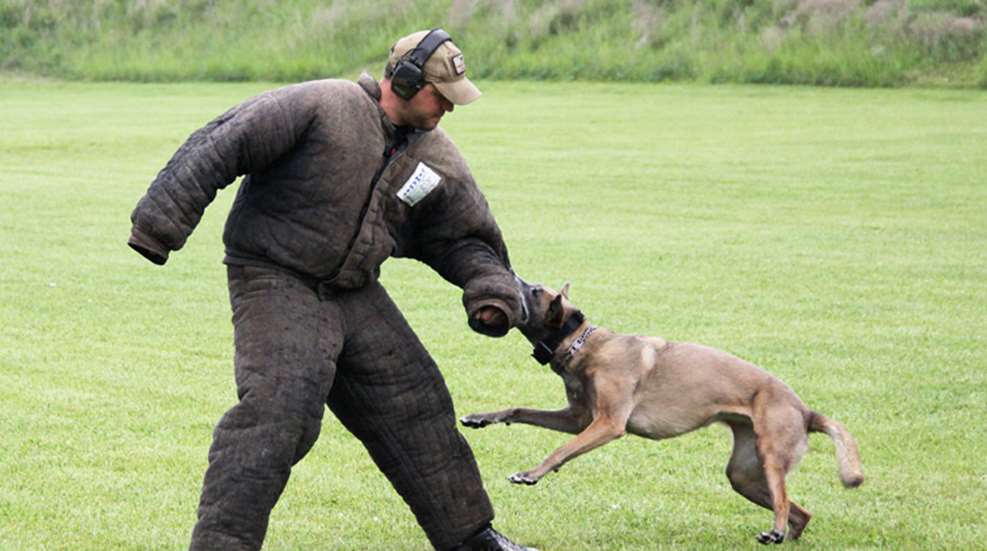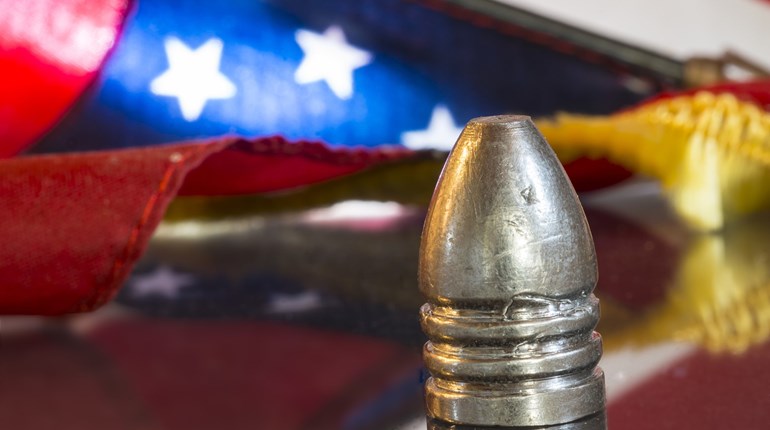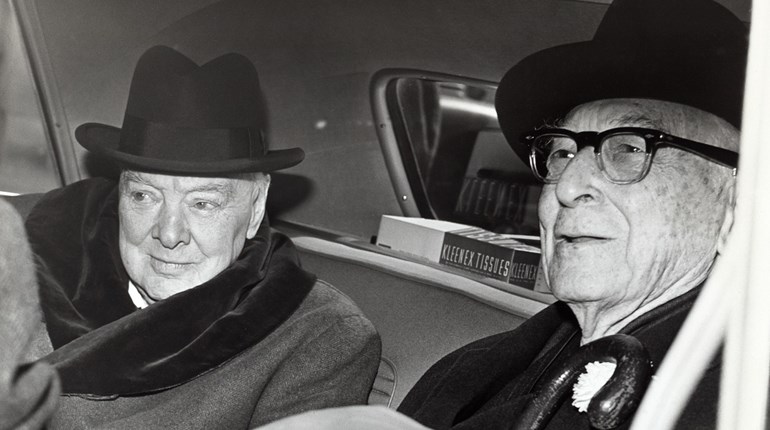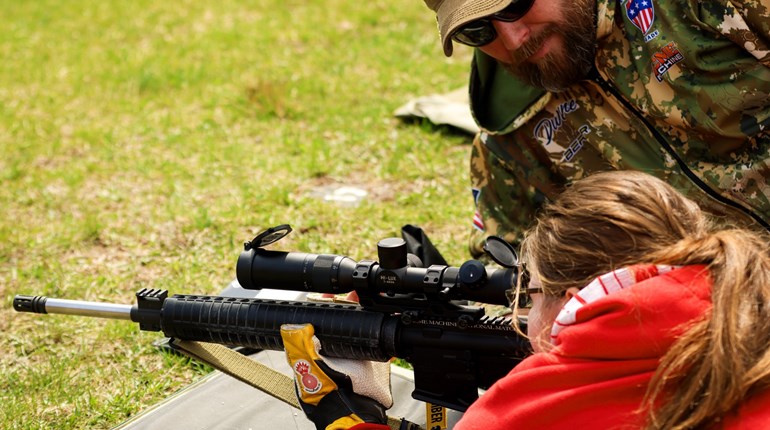
Mike Pennington began his law enforcement career working for the Franklin County Sheriff’s Office, responding to calls in the greater Columbus, Ohio, area, home to more than one million people. But while working his way up from deputy to the SWAT team to having a K-9 unit, Pennington was injured on the job and forced to retire from law enforcement in 2006.
“That’s when I had to decide what I was going to do with the rest of my life,” said Pennington. “I had a passion for both working with dogs and staying within the law enforcement community, so put those two interests together to form Storm Dog Tactical, a business training police, military and civilian home-defense dogs. I wake up every morning loving what I do.”
Pennington and his staff of four other trainers train mainly German shepherds and a more unusual breed, the Belgian Malinois (pronounced MAL-in-wha). “I prefer the Malinois because the dog’s bone structure is more suitable than the German Shepherd for law enforcement work,” said Pennington. “And you can generally expect two to four more years of service from a Malinois as opposed to a German shepherd.”
He said that a Malinois also tends to have an overall higher drive than a German shepherd. A Malinois looks something like a cross between a German shepherd and a greyhound. Pennington went on to explain that most police and military dogs are injured not from the rigorous training and work they do, but because of the constant beating their bodies take during transport.
“Think of it as you trying to stand up in the bed of a moving pickup truck as someone drives it erratically,” he said. “During a vehicle pursuit, for instance, when an officer accelerates rapidly, his dog hits the back of the transport crate. And when the officer jams on the brakes, the dog slides to the front of the crate. In a sense, these dogs are riding a surfboard 40 hours per week, every week of their working lives.
“We train our police dogs in three skill sets,” Pennington continued, “suspect apprehension, evidence recovery and detection. Suspect apprehension includes searching buildings, tracking and air-scent work where the dogs smell for human odor. Evidence recovery involves finding objects that may have been pitched by a suspect, such as when a bad guy throws a gun during a foot pursuit. We also routinely train for narcotics detection and have even trained cadaver dogs.”
To prepare yourself for such a career, Pennington said that a police or military background is essential, as well as a love for working with and training dogs. Asked what he enjoys most about his job, he mentioned the satisfaction derived from seeing a dog he’s trained perform well. He also enjoys rubbing shoulders with law enforcement officers and military personnel.
“I look at every dog as a challenge,” he said. “It’s relatively easy to train a dog to do a specific task, but my passion is in training a dog mentally. Much like training a handler to deal with stressful situations, we also train his/her dog to handle stressful situations, too. The mental side of a dog’s training is extremely important. Again, we can train for a task, but if we don’t also train the dog how to handle the build up of stress before and during an incident they simply won’t perform at their peak. It’s much like an athlete who does great in practice but doesn’t perform well on game day because he’s distracted by the crowd.”
Pennington went on to say that it takes both a good handler and a good dog to make a good K-9 team. “If you don’t have a high level of commitment on both ends of the leash, that team will not be as good as it could be. And a handler’s family must also make a commitment to having the dog become part of their family. If you think about it, a handler spends more time with his/her dog than they do their spouse or children, simply because the dog goes to work with them every day. As a result, there is a bond that develops between the two like no other.”
Storm Dog Tactical also trains dogs for civilian work. In addition to training dogs to do mold detection and bedbug detection, one side of the business that has increased in recent years is training dogs for home defense.
“For instance,” said Pennington, “when someone knocks at the door, it’s natural for most dogs to run to the door and bark. And if an intruder enters the house, most dogs will continue to bark but back up. Our dogs are trained to continue barking but stand their ground. The idea is to create time and distance between the homeowner and the bad guy, giving the homeowner and his family added time to react.”
It’s interesting to note that gun owners are a larger part of Pennington’s civilian-based clientele than non-gun owners. “Firearms owners seem to be more aware of personal safety concerns,” he said, “and as a result they are contacting us in increasing numbers. When I first began my business it was split about 50-50 between gun owners and non-gun owners. My guess now is that 80 to 85 percent of our clients are huge Second Amendment supporters. I believe it’s a sign of our times and how things are changing in an increasingly dangerous world.”
If you’re thinking about obtaining a dog for home defense, Pennington suggests choosing one of the working breeds—German shepherd, Belgian Malinois, Doberman pinscher, rottweiler, etc.—for the simple fact that those breeds have a higher intimidation factor for an intruder than, say, a hunting breed. Most are also black in color, which adds to their intimidating looks.
But if you’d rather Storm Dog Tactical choose and train a home-defense dog for you, it won’t come cheap. Prices begin at $18,500.
“We select and train a dog for each individual client,” Pennington said. “The training of a home-defense dog is the easy part. What is more difficult is matching that dog to a family, that family’s lifestyle and the environment the dog will live in.
“For instance,” said Pennington, “will the dog be required to travel frequently? We have some clients who own their own aircraft and travel extensively for both business and pleasure. We want to match that client with a dog that can adapt to that kind of lifestyle. Other clients already have three or four other dogs, so we must choose and train a home-defense dog that will fit into that situation. Yet other clients own yachts and are on the water for weeks at a time. For those clients we have to teach the dog to use a Puppy Pad when urinating or defecating. In essence, we don’t just have a cookie-cutter style of training where one dog fits all.”
In concluding, Pennington gave the example of one of his civilian clients who owns several carwashes. “This man had been robbed several times while removing money from the machines at the carwashes,” Pennington said. “He came to us for help and we trained a dog that would sit by his side, facing rearward, as the man removed the money. If the dog spotted someone approaching, it was trained to begin barking. And if the person came close enough, the dog was trained to attack. Problem solved…”





































